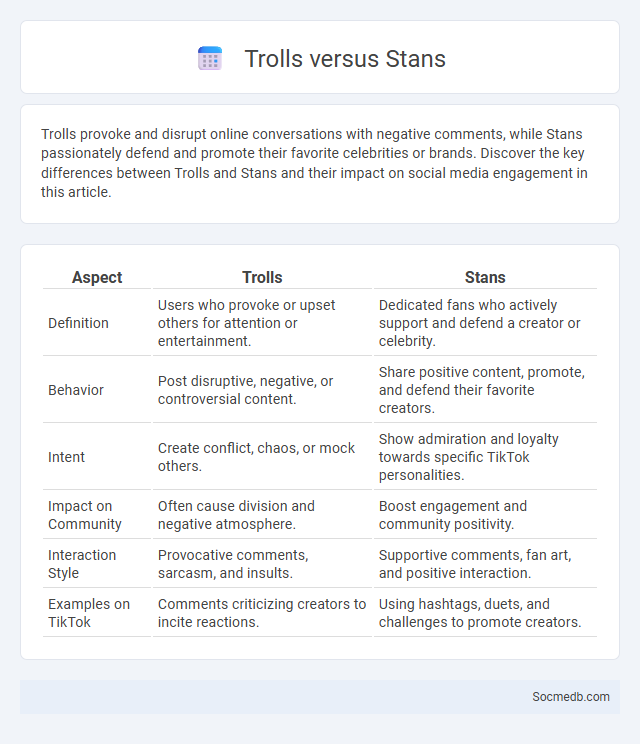
Photo illustration: Trolls vs Stans
Trolls provoke and disrupt online conversations with negative comments, while Stans passionately defend and promote their favorite celebrities or brands. Discover the key differences between Trolls and Stans and their impact on social media engagement in this article.
Table of Comparison
| Aspect | Trolls | Stans |
|---|---|---|
| Definition | Users who provoke or upset others for attention or entertainment. | Dedicated fans who actively support and defend a creator or celebrity. |
| Behavior | Post disruptive, negative, or controversial content. | Share positive content, promote, and defend their favorite creators. |
| Intent | Create conflict, chaos, or mock others. | Show admiration and loyalty towards specific TikTok personalities. |
| Impact on Community | Often cause division and negative atmosphere. | Boost engagement and community positivity. |
| Interaction Style | Provocative comments, sarcasm, and insults. | Supportive comments, fan art, and positive interaction. |
| Examples on TikTok | Comments criticizing creators to incite reactions. | Using hashtags, duets, and challenges to promote creators. |
Understanding Internet Subcultures: Trolls and Stans
Internet subcultures such as trolls and stans play distinct roles in shaping online social dynamics, with trolls often provoking or disrupting conversations to elicit strong reactions. Stans, on the other hand, exhibit intense fan loyalty, frequently defending and promoting celebrities or content creators across platforms like Twitter and TikTok. Analyzing their behaviors provides insights into digital community engagement, influence patterns, and the spread of viral content in social media ecosystems.
The Origins of Trolls and Stans Online
The origins of trolls trace back to early internet forums and bulletin board systems where users posted provocative content to elicit emotional responses and disrupt conversations. Stans, a term derived from Eminem's 2000 song "Stan," evolved to describe fervent fans who aggressively promote their favorite celebrities or interests across social media platforms. These online behaviors have significantly shaped digital culture, influencing user interactions and community dynamics on sites like Reddit, Twitter, and Tumblr.
Behavioral Differences: Trolls vs Stans
Trolls engage in social media by deliberately provoking and antagonizing users to disrupt conversations and elicit emotional reactions, often spreading misinformation or offensive content. Stans exhibit intense loyalty and support for a particular person, brand, or cause, frequently defending them passionately and amplifying positive messaging. The behavioral differences lie in trolls seeking conflict and chaos, whereas stans promote engagement through admiration and collective identity.
Motivations Behind Trolling and Stanning
Trolling often stems from a desire for attention, power, or reaction within social media communities, where individuals may seek to disrupt conversations for entertainment or influence. Stanning, by contrast, is driven by intense admiration and support for celebrities or content creators, reflecting a strong emotional investment and community belonging. Understanding these motivations helps you navigate online interactions with greater awareness and resilience.
Troll Tactics: How Online Trolls Operate
Online trolls employ tactics such as spreading misinformation, using inflammatory language, and creating fake profiles to provoke emotional responses and disrupt conversations. They often target vulnerable individuals or sensitive topics to maximize impact and amplify discord within social media communities. Understanding these troll tactics can help you navigate online interactions more safely and protect your digital presence.
Stans Explained: Passionate Support or Toxic Fandom?
Stans represent highly dedicated fans whose intense passion can drive vibrant online communities and boost content visibility. Your engagement with stans can amplify conversations, but unchecked toxicity risks alienating broader audiences and sparking social media conflicts. Understanding stan culture is crucial for balancing enthusiasm with respectful interactions in digital spaces.
The Impact of Trolls and Stans on Social Media Discourse
Trolls disrupt social media discourse by spreading misinformation, inciting conflict, and derailing meaningful conversations, which can damage community trust and engagement. Stans amplify content through intense support, sometimes fostering echo chambers that limit diverse perspectives and escalate fan conflicts. Understanding these dynamics helps you navigate and contribute to healthier, more balanced social media environments.
Conflict and Clashes: When Trolls Meet Stans
Social media platforms amplify conflicts when trolls engage with stans, intensifying online clashes through targeted harassment and inflammatory comments. Trolls exploit the passionate loyalty of stans, fueling polarizing debates and deepening divisions within fan communities. This volatile interaction often results in collective backlash, disrupting constructive discourse and escalating digital hostility.
Coping with Troll and Stan Behavior Online
Dealing with trolls requires maintaining emotional distance and avoiding engagement that fuels their provocations, while using platform tools like blocking and reporting to minimize their impact. Stan behavior, characterized by obsessive and sometimes aggressive fan interactions, can disrupt online communities, so setting clear boundaries and promoting respectful dialogue is essential. Employing moderation strategies and fostering digital literacy helps create safer social media spaces by encouraging constructive participation and reducing toxic interactions.
The Future of Internet Fandoms: From Trolling to Stanning
Internet fandoms are evolving with social media platforms fostering more interactive and engaged communities, shifting from negative behaviors like trolling to positive expressions of support known as stanning. Advances in AI-driven moderation and algorithmic content curation are reducing toxic interactions while amplifying fan content that builds stronger community bonds. As fandoms adapt, platforms like Twitter, TikTok, and Discord become essential hubs for collaboration, creativity, and collective fan activism.
 socmedb.com
socmedb.com